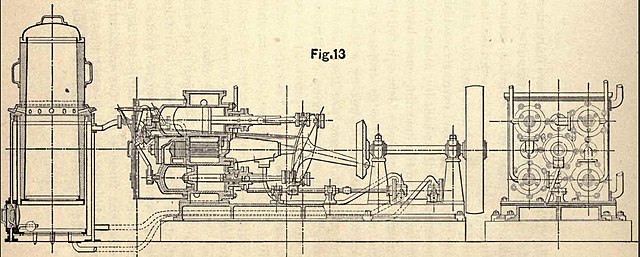Carl Wilhelm Siemens
Sir Charles William Siemens | |
|---|---|
Ernst Werner von Siemens | |
| Awards |
|
Sir Carl Wilhelm Siemens
Biography
Siemens was born in the village of Lenthe, today part of
On 23 July 1859, Siemens was married at St James's,
The early years
In the autumn of 1838 when William was fifteen years old, he began his studies to become an engineer. He attended a highly respected School of Trade and Commerce, the Gewerbe-Schule Magdeburg. William had a particularly close relationship with his eldest brother;
Once William had completed his course at the Magdeburg school he went on to the University of Göttingen where he attended lectures on physical geography and technology, high mathematics, theoretical chemistry and practical chemistry and physics. He was also able for a short time to work with Wilhelm Weber, the renowned scientist and inventor, in his Magnetic Observatory.
William was nearly nineteen when he left university to become an apprentice engineer. He also found time for more artistic pursuits such as taking dancing lessons and even painting a landscape of Nordhausen for the wife of the factory manager. His progress in the engineering factory was so rapid that his two-year apprenticeship was cut down to one.
Due to the education of the younger members of the family becoming a financial worry, on 10 March 1843, Carl Wilhelm Siemens left for London. He was acting as an agent for his brother Werner, and he hoped to earn enough money by selling a patent in England to help support and educate his many brothers and sisters. He felt a keen desire to see England and the journey cost him £1. William had already shown himself to be an enthusiastic businessman, having financed his trip by selling an invention of his brother's, an improvement to the gold and silver plating process, to George Richards Elkington. He was well aware, as he wrote to Werner, that his visit might achieve nothing, but if all went well he intended to remain. This indeed proved to be the case.
Career
Siemens had been trained as a mechanical engineer, and his most important work at this early stage was non-electrical; the greatest achievement of his life, the
Two years later he continued his experiments at the works of
In 1850 he established the London sales office of
In 1859 William Siemens devoted a great part of his time to electrical invention and research; and the number of telegraph apparatus of all sorts – telegraph cables, land lines, and their accessories – which have emanated from the Siemens Telegraph Works (at Charlton, SE London) has been remarkable. In 1872 Sir William Siemens became the first President of the Society of Telegraph Engineers which became the Institution of Electrical Engineers, the forerunner of the Institution of Engineering and Technology [1]

In 1860 William Siemens constructed a remarkable gas engine (the same year the very first commercial engine was produced by Lenoir). It didn't get beyond the experimental stage, though its principle of operation (described in Siemens British patent 2074 of 1860, and by Siemens in The Theory of the Gas Engine[4]) appears to be similar to the commercially successful Brayton engine of 1872. In the discussion section of The Theory of the Gas Engine Siemens discloses that :
"The engine promised to give very good results, but about the same time he began to give his attention to the production of intense heat in furnaces, and having to make his choice between the two subjects, he selected the furnace and the metallurgic process leading out of it; and that was why the engine had remained where it was for so long a time."
Siemens was also responsible for the hot tube ignition system used on many of the early gas engines.[5]
In June 1862 he was elected a
As a member of the circumnavigation committee preparing the oceanographic expedition of HMS Challenger, Siemens was commissioned in 1871 to develop an electric thermometer to measure the temperature of the ocean at different depths.[7]
He was elected as a member to the American Philosophical Society in 1877.[8]
The

In 1874 he had a special
See also
References
- ^ Paths of Glory. Friends of Kensal Green Cemetery. 1997. p. 89.
- ^ "Wills". The Times. No. 36913. London. 31 October 1902. p. 10.
- ^ "Halfway around the world in 28 minutes – Building the Indo-European Telegraph Line". Siemens Historical Institute. Archived from the original on 5 June 2019. Retrieved 17 June 2019.
- ^ Dugald Clerk. The Theory of the Gas Engine, D. Van Nostrand, New York, 1882
- ^ Dugald Clerk, "Gas and Oil Engines", Longman Green & Co, (7th Edition) 1897, p224
- ^ "Library and Archive Catalogue". Royal Society. Retrieved 15 October 2010.[permanent dead link]
- S2CID 182882300.
- ^ "APS Member History". search.amphilsoc.org. Retrieved 10 May 2021.
Sources
- Shaping the Future. The Siemens Entrepreneurs 1847–2018. Ed. Siemens Historical Institute, Hamburg 2018, ISBN 9-783867-746243.
- William Pole, Life of William Siemens, (London, 1888), p. 471; Facsimile reprint Siemens Ltd. 1986, ISBN 1-85260-416-6
- Richard Hennig, Buch der berühmten Ingenieure (A book on famous engineers), (Leipzig, 1911)
- Thurston, Robert H. (1884). "Charles William Siemens". Proceedings of the Royal Society of London. 37 (49): i–x. PMID 17736598.
- J. A. Ewing (1887). "Siemens, Sir William". Encyclopædia Britannica. 9: 22:37–38.
- Sir William Siemens – A Man of Vision, A collection of articles by various authors published by Siemens plc in 1993, contains substantial material on the history of Siemens in the UK
External links
- Wood, H. T.; Bowers, B. (January 2011). "Siemens, Sir (Charles) William [formerly Karl Wilhelm] (1823–1883)". required.)
- Profile from the Siemens company
- Past IEE Presidents
- Portrait of Carl Wilhelm Siemens from the Lick Observatory Records Digital Archive, UC Santa Cruz Library's Digital Collections Archived 15 August 2020 at the Wayback Machine
